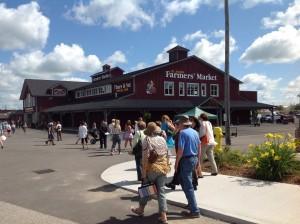
St Jacob’s Farmers Market
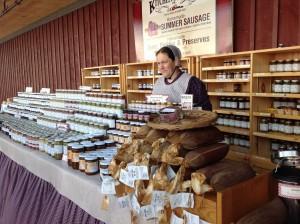
St Jacob’s Farmers Market – homemade Mennonite sausages & pickles for sale
Today we would be touring the area of this unique community to discover the attributes that draw the visitor to this Mennonite region. My familiarity with the Mennonites was that of a group of people who lived the life of tradition, hard-working, and with no amenities of the modern age. A good hardy people who basically kept to themselves.
The first stop on our tour was the St. Jacob’s Farmers and Flea Market in the heart of the Mennonite countryside located about 8 kms (5 mi) from St. Jacob’s Village. It is Canada’s largest year-round farmer’s market, and is a symbol of Mennonite life in Ontario. It is also the heart of activity for the approximately 4,000 Old Order Mennonites who still practice their traditional lifestyle that revolves around farming. The Market is the venue where many of their farm products and crafts are displayed and sold.
The original 2,230 sq m (24,000 sq ft) building built in 1936 that attracted annually some one million visitors burned down on Labour Day of 2013 but reopened as a spacious and bright 3,159 sq m (34,000 sq ft) structure in June 2015 which will undoubtedly attract even more.
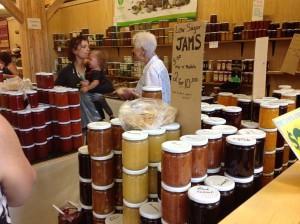
St Jacob’s Farmers Market – homemade jams, jellies and pickles for sale
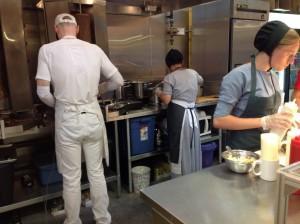
St Jacob’s Farmers Market – preparing shawarma and kebabs
But Mennonite culture predominates. The sausages and meats, the variety of cheeses, the preserves of jams and jellies (even low-sugar!), pickles, syrups, pierogis, noodles, the freshly fried doughnuts and fritters with maple syrup, home-made chips and breads all remind us of the non-eraseable identity of the Mennonites, preserving their heritage and traditions for the world to see at St. Jacob’s Farmers’ Market.
The apple fritters took us by storm. Fresh, hot and crispy, we thought this was the ultimate of Mennonite foods, that is, until we sampled the renowned Mennonite sausage, sliced thick, it becomes Mennonite ‘steak’. Even the pierogis, a food that I’ve never really relished, tasted good in their Mennonite version. If only time had given us the chance to sample the maple syrup and preserves.
Leaving the Market, we climbed aboard a tourist train, a train that connects to the heart of the Village of St. Jacob’s carrying visitors and Market shoppers alike to and from the Market. Volunteers operate this steam and diesel-hauled train. A vintage adventure in transport, the train starts at St. Jacob’s Farmers’ Market and ends at the Village of St. Jacob’s after crossing the Conestogo River.
We walked a short distance from the train stop and reached the Village-centre. The Village itself is steeped in history and known for its original arts and crafts, quite evident from its studios and galleries where one can meet the artisans themselves. In addition, it offers great shopping from boutique clothing and jewellery, to gourmet foods, and handmade goods and now prides itself as site for fine-dining featuring regional cuisine.
Our objective was to spend some time in the multi-media interpretive ‘Mennonite Story’ center on King Street, an informative place for those interested in the history, religion, and culture of the Mennonites in Ontario and beyond. Displays, artifacts, photos, and slide presentations are promoted as being detailed and extensive. So well-organized is this place that audio is available in a half dozen languages. But alas, our time was limited and we were unable to visit as we had an appointment for lunch in nearby Waterloo.

St. Jacob’s-Cambridge – Langdon Hall gardens
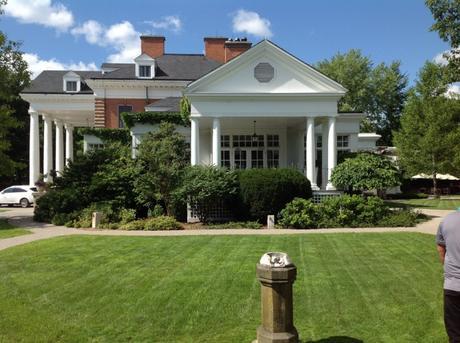
St. Jacob’s-Cambridge – Langdon Hall
Continuing our journey, we stopped for awhile at the Fashion Museum in Cambridge celebrating dress design of the 19th to the 20th centuries. A strange combination of fashion from the elegant lace of French 19th century lace dress and footwear to the wild square-shouldered dress of David Bowie and the elegant crisp suits of Eva Peron. With this aura of elegance, we ended our tour of the traditional to the modern. I have to admit, I did not see one horse or buggy other than those parked at the market for those for tourists to try. The Mennonites have truly left their mark in the Waterloo region.
For Further Information, Contact:
St. Jacobs Farmers’ Market: P.O. Box 443, 878 Weber St. North, Waterloo ON N2J 4A9; Tel: 519-747-1830; E-mail: [email protected]; Website: www.stjacobs.com/farmers-market
Langdon Hall Country House Hotel and Spa: 1 Langdon Drive, Cambridge, ON N3H 4R8; Tel: 519-740-2100; E-mail: [email protected] ; Website: www.langdonhall.ca
Waterloo Regional Tourism: Suite 201, 260 King Street West Kitchener, ON N2G 1B6; Tel: 519-585-7517 ext. 250; Fax: 519-585-7893: E-mail: [email protected]; Website: www.explorewaterlooregion.com
-

- St. Jacob’s – author Habeeb Salloum enjoying homemade apple fritters on train to the Village
-

- St. Jacob’s-Cambridge – Langdon Hall – Chef’s Citrus Herb Marinated Tuna with Garden Garnishes plated
-
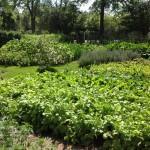
- St. Jacob’s-Cambridge – Langdon Hall – hotel’s vegetable & herb garden
-
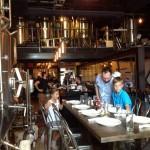
- St. Jacob’s-Waterloo – Abe Erb craft beer brewery restaurant



COMMENTS ( 1 )
posted on 24 August at 13:28
I am really grateful to the owner of this web page who has shared this great post at here.